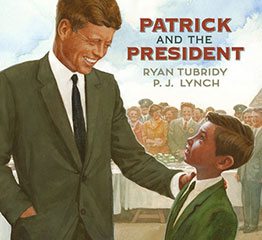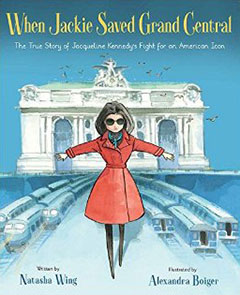 America has a fine tradition of elected officials who care deeply about the people, places, and policies of the United States of America. Two recent books highlight the good works of, and respect for, Jacqueline Bouvier Kennedy Onassis and John Fitzgerald Kennedy, the First Lady and President from 1961 to 1963. Although President Kennedy was assassinated just two short years into his term as President, the First Lady continued her work for the benefit of the people throughout her life.
America has a fine tradition of elected officials who care deeply about the people, places, and policies of the United States of America. Two recent books highlight the good works of, and respect for, Jacqueline Bouvier Kennedy Onassis and John Fitzgerald Kennedy, the First Lady and President from 1961 to 1963. Although President Kennedy was assassinated just two short years into his term as President, the First Lady continued her work for the benefit of the people throughout her life.
In Patrick and the President, Ireland’s Late Late Show host, Ryan Tubridy, has written his first children’s book about President John F. Kennedy’s visit to his ancestral homeland, Ireland. In June of 1963, President Kennedy spent four days in various cities, visiting sites and meeting people. This book shares one boy’s experience of meeting the President.
Patrick Kennedy, John’s great-grandfather, left Ireland in 1848 aboard a famine ship. Many people in Ireland relied solely on potatoes as their food source, so when a blight affected the potato crop, nearly one million people starved to death and one million people emigrated to America. The immigrants retained a strong love for their original country, which they passed along to their children and grandchildren. John F. Kennedy’s decision to visit Ireland was heralded by Irish people on both sides of the ocean.
The language of this story beautifully portrays the excitement the entire town felt as they welcomed this world-famous Irish descendant back to the land of his roots. Patrick, the boy in the story, will be part of the children’s choir singing “The Boys of Wexford” when the President visits … and his father negotiates a chance for Patrick to help serve tea to the President when he visits the Ryans and Kennedys in New Ross. Emotions are high and expectations are tense: who will get to talk with “Himself”?
Tubridy is the author of a book written for adults: JFK in Ireland: Four Days That Changed a President. The information here is distilled in a way that feels personal and immediate. Every child will identify with young Patrick, knowing full well what it feels like to have high hopes for something.
P.J. Lynch, currently the Children’s Laureate of Ireland, contributes nearly photographic illustrations of Patrick, his family, the helicopters, the President, and the food.
There are two pages in the back matter that list Kennedy’s itinerary during his four-day visit, along with three sepia-toned photos. Don’t miss reading this information — it’s quite interesting.
The closeups and focus on Patrick and his family bring a palpable excitement to the book, which encourages reading throughout a somewhat long but ultimately satisfying text. This would make a good read-aloud for discussing several things in class. Who was President Kennedy? What do families mean to us? From where did our forebears immigrate? What do these connections across oceans and time mean for our world?
Patrick and the President
written by Ryan Tubridy, illustrated by P.J. Lynch
Candlewick Press, 2017
ISBN 978−0−7636−8949−0, $16.99

Natasha Wing wrote one of my favorite picture book biographies, An Eye for Color: the Story of Josef Albers, so I was excited to learn that she has written a book about historic preservation, starring none other than Jacqueline Kennedy Onassis.
 As First Lady of the United States for two years, she captured the attention and imagination of every newspaper, magazine, and newsreel in the land. Women adopted her fashion sense and hairstyle. She did a great deal to restore the grandeur of the White House and would undoubtedly have done more had she been in residence there longer.
As First Lady of the United States for two years, she captured the attention and imagination of every newspaper, magazine, and newsreel in the land. Women adopted her fashion sense and hairstyle. She did a great deal to restore the grandeur of the White House and would undoubtedly have done more had she been in residence there longer.
Returning to live in New York City, the city in which she grew up, Mrs. Kennedy learned that Grand Central Station was in danger of being altered with a skyscraper built on its roof!
“Like a powerful locomotive, Jackie led the charge to preserve the landmark she and New York City loved. She joined city leaders and founded the Committee to Save Grand Central. She spoke at press conferences and made headlines.
“She inspired citizens to donate money. When people across the United States saw their fashionable former First Lady championing her cause, New York City’s fight became America’s fight.”
In other words, only Jacqueline Kennedy could promote a cause in a way that resulted in the National Historic Preservation Act of 1966, under which Grand Central Station could find the protection it needed to be restored to its former grandeur.
The text is written with such clarity and verve that the reader will want to look for an historic building of their own to save! An extensive author’s note provides more information that will prompt some children to adopt this as a cause of their own.
The illustrations by Alexandra Boiger are energetic and whimsical, all the while using color to subtly emphasize parts of the story. In “A Note from the Illustrator,” you’ll find much to discuss about the colors she uses while you pore back over the book to find examples.
For a classroom, this is a terrific way to begin talking about the buildings we see every day, why they are important to a community, and what they mean for our future.
When Jackie Saved Grand Central:
The True Story of Jacqueline Kennedy’s Fight for an American Icon
written by Natasha Wing, illustrated by Alexandra Boiger
Houghton Mifflin Harcourt, 2017
